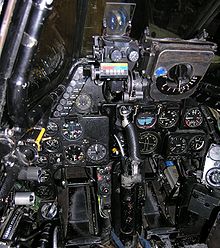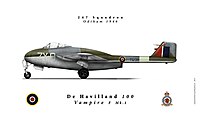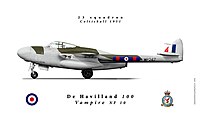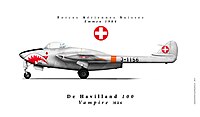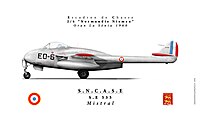De Havilland DH.100 vampires
| de Havilland DH.100 Vampire / DH.115 Vampire Trainer | |
|---|---|
 De Havilland Vampire FB.6 |
|
| Type: | single-engine fighter aircraft |
| Design country: | |
| Manufacturer: | |
| First flight: |
September 30, 1943 |
| Commissioning: |
1945 |
| Number of pieces: |
4,400 (including 3,268 English production) |
The De Havilland DH.100 / 113/115 Vampire (originally also: Spidercrab ) is a single- engine fighter aircraft produced by the British manufacturer de Havilland Aircraft Company . Although it was still operational in the final phase of World War II , it no longer took part in combat operations.
A total of 4400 machines were built for numerous customers, around 1100 of them under license. Vampires remained in Great Britain until 1955, as a training aircraft until 1966 (in Switzerland until 1990) in use. In the 1950s they also flew with units of the RAF Germany .
history


The development began initially as an experimental aircraft in the summer of 1942 according to the specification E.6 / 41. The first flight of the prototype with the registration number LZ548 / G took place on September 30, 1943 and was carried out by Geoffrey de Havilland jun. carried out. The flight test was delayed when the only available engine had to be sent to the USA to replace the only damaged engine there on the Lockheed P-80 . Due to the fact that de Havilland was busy with other types of aircraft, series production was also delayed, so that the first machine in the Mk I production series did not start its maiden flight until April 1945.
The machine showed very good flight performance and flight characteristics. It was the first British model to reach a top speed of more than 500 miles per hour (about 806 km / h). On December 3, 1945, test pilot Eric Melrose Brown landed and took off from an aircraft carrier ( HMS Ocean ) as the first jet engine-powered aircraft . In 1948 it reached a new altitude record of 18,119 m.
Based on the positive tests, a special version was developed for the Fleet Air Arm with the DH.100 Mk.5 Sea Vampire . In addition to its role as a fighter aircraft, the Sea Vampire could also be used as a ground attack aircraft.
The DH.113 was a two-seater night fighter with appropriate radar equipment that was created in 1949 and was originally intended for Egypt. The DH.115 training aircraft was created on this basis.
The last version produced was the DH.100 Mk.11 or DH.115 training aircraft, which came into service from 1950 and of which over 600 units have been produced.
construction
The single-seat unswept means Decker was in all-metal construction fabricated. An exception, however, was the cockpit section, where balsa and plywood components, similar to the de Havilland Mosquito , were also used. The Vampire was equipped with a retractable nose wheel landing gear and was propelled by a jet engine. The double tail girders were characteristic . However, this design made it very difficult for a pilot to exit in the event of an emergency; it was actually only possible if the pilot still had time to lay the aircraft on its back after the canopy was removed. This weak point was eliminated by installing ejection seats , which in Switzerland only took a decade of operation.
variants
The following series were developed for the air forces of the United Kingdom and some other nations:
- DH.100
- Single-seat prototype with a de Havilland Halford H1 / Goblin I , 3 engine built
- Vampire Mk.1 (also F.1)
- Original day chase variant with Goblin I / II engines for the Royal Air Force (RAF), 244 built, 4 aircraft to Switzerland.
- Vampire Mk.2
- Version with Rolls-Royce Nene engine, 1 built, 2 converted
- Vampires F.3
- Day fighters, two upgraded Mk.1, 202 for the RAF and 20 for the Norwegian Luftforsvaret built
- Vampire Mk.4
- Project with Nene engine, not realized
- Vampire FB.5
- original fighter-bomber variant with Goblin II engine, 930 built for the RAF and 20 built for export
- Vampire FB.6
- improved fighter-bomber variant with Goblin-3 engine, 178 for the RAF and 100 locally under license for the Swiss Air Force built
- Vampire Mk.8
- Pattern with de Havilland Ghost engine, 1 converted Mk.1
- Vampire FB.9
- Compared to the FB.5, improved fighter-bomber with air conditioning for use in the tropics, 326 built
- DH.113
- Prototype of a two-seater night chase variant with a goblin engine, 2 built
- Vampires NF.10
- Series version of the two-seater night fighter built for the RAF, 66
- DH.115
- Prototype of a two-seater training variant and common name of the T.Mk.55 in Switzerland
- Vampires T.11
- Series version of the two-seat trainer for the RAF, built 731
The following series were developed for use on aircraft carriers of the British Royal Navy :
- Sea Vampire Mk.10
- Prototype for deck tests, 1 converted
- Sea Vampires F.20
- Marine version of the FB.5 for the Fleet Air Arm (FAA), built by English Electric 18
- Sea Vampire Mk.21
- Trial series with reinforced floor and catch hook for landing tests with retracted landing gear on flexible carrier decks, 6 converted F.3
- Sea Vampire T.22
- Series version of the two-seater trainer for the FAA, 73 built
The following series were created for the armed forces of the two large South Pacific Commonwealth countries:
- Vampire FB.25
- Designation of FB.5 for the Royal New Zealand Air Force (RNZAF), built 25
- Vampires F.30
- Nene-powered fighter for the Royal New Zealand Air Force (RAAF), built 80 locally under license
- Vampire FB.31
- Nene-powered fighter-bombers for the RAAF, 29 built on site under license
- Vampires F.32
- Variant of the Australian fighter with air conditioning, 1 converted
- Vampires T.33
- Two-seat trainer for the RAAF with a goblin engine, 36 built on site under license
- Vampires T.34
- Two-seat trainer for the Royal Australian Navy (RAN), 5 built on site under license
- Vampires T.34A
- Version of the T.34 with ejection seats
- Vampires T.35
- Improved trainer for the RAAF, built 68 on site under license
- Vampire T.35A
- Version of T.35, upgraded T.33
The last series were exports to other NATO countries:
- Vampire FB.50
- Export model for the Swedish Flygvapnet , designated there as J 28B, built 310
- Vampire FB.51
- Prototype for export to France with Nene engine, 1 rebuilt
- Vampire FB.52
- Export model of FB.6, 101 built (36 for Norway)
- Vampire FB.52A
- Export model of the FB.6 for the Italian Aeronautica Militare (AMI), 80 built on site under license
- Vampire FB.53
- Production model the FB.51 for the French Armee de l'Air , there as Sud-Est SE.532 / SE.535 Mistral referred
- SE.532 Mistral
- Variant with Nene 102B engine, built in 94 on site under license
- SE.535 Mistral
- Variant with Nene 104 engine and ejection seat, 150 built on site under license
- Vampires NF.54
- Export model of NF.10 the AMI, 29 built on site under license
- Vampires T.55
- Export model of the T.11, 216 built, 6 converted T.11 and 12 in Sweden converted FB.50
Users
-
 Egypt
Egypt
-
 Australia
Australia
-
 Burma
Burma
-
 Ceylon
Ceylon
-
 Chile
Chile
-
 Dominican Republic : 25 × F.1 (ex Sweden) + 17 × FB.50 (ex Sweden)
Dominican Republic : 25 × F.1 (ex Sweden) + 17 × FB.50 (ex Sweden) -
 Finland
Finland
-
 France
France
-
 India
India
-
 Indonesia : 6 × T.11
Indonesia : 6 × T.11 -
 Iraq
Iraq
-
 Ireland
Ireland
-
 Italy
Italy
-
 Japan : 1 × T.55 for evaluation in 1955
Japan : 1 × T.55 for evaluation in 1955 -
 Jordan
Jordan
-
 Canada
Canada
-
 Katanga : 2 ex Portugal T.11
Katanga : 2 ex Portugal T.11 -
 Lebanon
Lebanon
-
 Mexico
Mexico
-
 New Zealand
New Zealand
-
 Norway
Norway
-
 Austria : 4 × T.55 from 1964–1972 a. 5 × T.11 1957-1971
Austria : 4 × T.55 from 1964–1972 a. 5 × T.11 1957-1971 -
 Portugal
Portugal
-
 Republic of the Congo
Republic of the Congo
-
 Rhodesia
Rhodesia
-
 Sweden : 70 × F.1 (J 28A), 310 FB.50 (J 28B); 57 T.55 (J 28C)
Sweden : 70 × F.1 (J 28A), 310 FB.50 (J 28B); 57 T.55 (J 28C) -
 Switzerland : 4 × Mk 1, 178 Mk 6, 1 × DH.113NF Mk10, 39 × DH.115
Switzerland : 4 × Mk 1, 178 Mk 6, 1 × DH.113NF Mk10, 39 × DH.115 -
 South African Union
South African Union
-
 Syria
Syria
-
 Venezuela
Venezuela
-
 United Kingdom
United Kingdom
Station locations in Germany
-
Royal Air Force Germany
- RAF Brüggen , July 1953 to January 1954, Vampire FB5 (112th Squadron)
- RAF Celle , November 1950 to January 1954, (93rd and 94th Squadron)
- RAF Gütersloh , June 1948 to April 1952, Vampire F1 / FB5 (3rd, 16th, 26th, 67th and 71st Squadron)
- RAF Fassberg , May 1951 to May 1953, Vampire FB5 (112th and 118th Squadron)
- RAF Jever , March 1952 to July 1953, Vampire FB5 (4th, 93rd and 112th Squadron)
- RAF Oldenburg , May 1952 to November 1953, Vampire FB5 / FB9 (20th, 26th and 234th Squadron)
- RAF Wildenrath , April 1952 to October 1953, Vampire FB5 (3rd, 67th and 71st Squadron)
- RAF Wunstorf , April to June 1948, Vampire F1 (3rd Squadron) and January 1950 to October 1953, Vampire FB5 / FB5B (4th, 11th, 26th Squadron)
-
(French) Armée de l'air
- BA Bremgarten , April 1954 to July 1954, Vampire Mk.1 (4ème Escadre Chasse)
- BA Friedrichshafen , October 1949 to April 1954, Vampire Mk.1 (4ème Escadre Chasse)
Technical data (Vampire FB 5)
| Parameter | Data |
|---|---|
| crew | 1 |
| length | 9.37 m |
| span | 11.58 m |
| height | 1.88 m |
| Empty mass | 3297 kg |
| Takeoff mass | 5618 kg |
| Top speed | 825 km / h at an altitude of 7500 m |
| Service ceiling | 12,200 m |
| Range | 1755 km |
| Engines | a de Havilland Goblin 2 jet engine with 13.8 kN thrust |
Armament
- Guns mounted in the fuselage
- 4 × 20 mm automatic cannon Hispano-Suiza Mk.V with 150 rounds of ammunition
- Ordnance up to 1,000 kg at several external load stations
- Unguided air-to-surface missiles
- 8 × launch rails for one unguided air-to-surface rocket RP-3 (Rocket Projectile 3-inch) each; Caliber 76.2 mm
- Unguided bombs
- 2 × Royal Ordnance 1000 lb (454 kg), free fall bomb
- 2 × Royal Ordnance 500 lb (227 kg), free fall bomb
- External container
- 2 × drop-off additional tanks for 455 liters (121 US gallons) of kerosene
- 2 × drop-off additional tanks for 227 liters (60 US gallons) of kerosene
Others
Because the machine tended to roll over in tight turns, the Swiss Air Force suffered several fatal accidents. Therefore gradually all machines got an ejection seat . Only single pilots were allowed to fly with the not yet converted “Vampires”.
Museum reception
A de Havilland DH 115 Vampire Mk.T55 of the Austrian Armed Forces is exhibited in the military aviation exhibition Zeltweg in Hangar 8 of the Hinterstoisser Air Base , a branch of the Vienna Museum of Military History .
In the Flieger-Flab-Museum in Dübendorf there is a vampire single seater, in which the cockpit could be climbed. The museum also has a two-seater DH 115.
The Swiss Aviation Museum in Altenrhein also has an airworthy DH 100 Vampire and a DH 115 Vampire Trainer from the Swiss Air Force.
In the Flygmuseum Ängelholm there is a no longer airworthy J28.
literature
- AJ Jackson: De Havilland Aircraft since 1909 , Putnam, 1962, 3rd edition 1978, ISBN 0-87021-896-4 , pp. 423-432
- Hans Prisi: Vampires, Vampire Trainer and Venom of the Swiss Air Force.
Web links
Individual evidence
- ^ AJ Jackson (1978), p. 423
- ↑ Swiss Air Force: The Vampire Airplane ( Memento from May 14, 2015 in the Internet Archive )
- ↑ Birtles 1986, p. 58.
- ↑ Military aircraft of the Austrian Armed Forces from 1955 on doppeladler.com
- ↑ Swiss Air Force Military IDs / Registrations ( Memento of 25 May 2015, Internet Archive )
- ↑ on doppeladler.com , accessed on September 10, 2013


